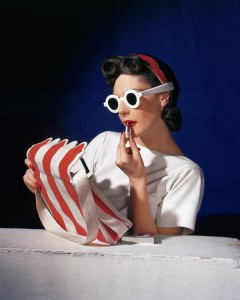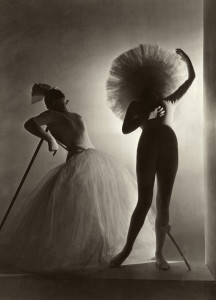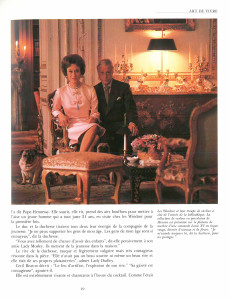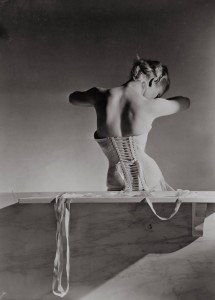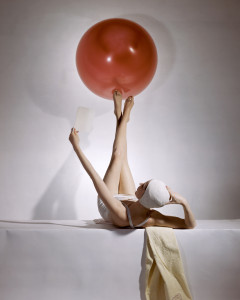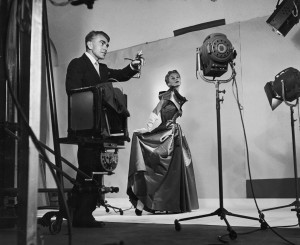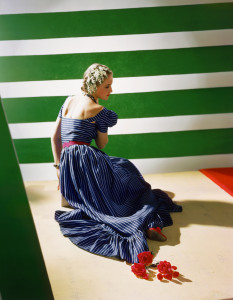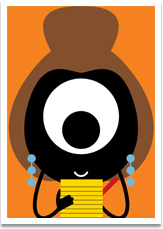Graphic black-and-white lines are drawn like a draughtsman’s plan. They run down a narrow space, following a geometric floor pattern, past the framed photographs of graceful models and down to a cluster of dresses on mannequins.
On the wall at the opening of this exhibition at the Victoria & Albert Museum in London is one word in stark, three-dimensional lettering: H O R S T.
The show is in homage to a photographer who went from Bauhaus to haute fashion over 60 fruitful years.
The result is a triumph for curator Susanna Brown, whose exhibition, Horst: Photographer of Style (until January 4), captures the man and his work with precision and clarity.
It starts with research into iconic photographs, showing the elegant chiaroscuro of light and shadow for which the photographer was famous in the Thirties.
It goes on to reveal Horst’s attachment to Salvador Dalí and the surrealists and his rigorous portraiture of stars of the silver screen, such as Rita Hayworth and Ginger Rogers. A final burst of colour appears as 94 Vogue magazine covers and 25 giant photographs, newly printed from the Condé Nast archive.
Throughout, the exhibition has a compelling energy and deep knowledge, but delicately expressed.
Susanna Brown has devoted a small part of the Horst show to the stylised eroticism of the photographer’s private work: the graphic intertwining of muscular male bodies in the Fifties that pre-dated the more explicit work of Robert Mapplethorpe in the Eighties. I noted that Horst’s body sculptures through the camera lens are loaned from the private collection of Elton John/David Furnish.
I have a particular affinity with Horst, although I never worked with him. Because when I was researching The Windsor Style – my book on the Duke and Duchess of Windsor – Valentine Lawford, Horst’s long-term partner, invited me to their home in Oyster Bay Cove in Long Island, where I glimpsed a lifetime of modernism, born from an apprenticeship with the architect Le Corbusier in 1930.
That streamlined style was interspersed with romantic touches such as the drawings of Christian Bérard; colourful, patterned Tunisian rugs; and the lush surrounding garden.
Valentine Lawford was still the same impeccably English foreign-office figure as when they had fallen in love in 1947. Together, we rummaged through shoe-box archives, looking at pictures of the Windsors at home in their Paris mansion with the debris of royal objects from before the abdication, and Wallis’s personal collection of Meissen pugs to match the live animals sitting at her feet.
Most of Horst’s work is exceptionally well known – meaning that these iconic pictures are familiar friends: Coco Chanel elongated on a sofa, her chiselled profile softened as she looks with love into the distance; Marlene Dietrich in her sober black suit and hat above smoky, lidded eyes.
And, of course, the photograph that really can be described as “iconic”: the laced Mainbocher corset from 1939 that was the last photograph Horst took before fleeing Paris for New York at the start of the war.
The models alone are legendary, sometimes part of society, like Gloria Vanderbilt, a pouting beauty in New York in 1941. Or the ever-present Swedish model Lisa Fonssagrives, as elegant in a Molyneux leopard skin coat as in classic black Chanel.
The curator calls Horst “a magician of light”. And she has found variations on the beautiful but familiar images, so that we can understand the process of the portraiture. For example, Carmen Dell’Orefice – the only Horst model still alive – is photographed having a face massage in 1946. The image is taken first straight on, then at a dramatic angle, as it was published.
In the well-researched book accompanying the exhibition, the model explains how Horst saw the classical beauty hidden behind her hair.
The clothes on show are from designers of the era such as Chanel, Lanvin, Maggy Rouff and Vionnet. They are not necessarily carbon copies of what is worn in the surrounding photographs, but have similar fashion gestures: liquid-metallic fabrics, or back ribbons and drapes that are reflected on the mirrored wall. The clothes are so tiny that the museum had to make bespoke mannequins.
The shock of moving from the first room of light and shadow to the bright, bold Dalí years is deliberate and effective. This section of Horst’s work with Elsa Schiaparelli and Dalí emphasises how much the visual arts were intertwined in that prolific Paris period before the two world wars.
Again, the exhibition comes up with surprises: there are Horst’s original pencil sketches of the Mainbocher corset image, while other drawing books are digitally installed so that the pages turn.
Another twenty-first-century effect is the instant access to the vast record of homes and gardens (including his own) photographed by Horst. A tap on a screen opens up pages of magazine articles.
I wished that the striking Vogue covers – starting in 1935 with Princess Sherbatow in red velvet – could also have been digitalised to show the magazines’ content.
Other elements of Horst’s oeuvre surprised me: the outdoor, post-war images of nature, showing close-ups of plants, shells and minerals – although I knew about the couple’s obsession with their Oyster Bay garden.
Just when you think this rich exhibition is coming to an end, there are other treats: a film of Horst directing a shoot, still looking like the young German boy who captivated Luchiano Visconti and Baron George Hoyningen-Huene, who mentored his protégé until pupil exceeded master.
I do not have enough photographic knowledge to grasp all the implications of the printing in platinum-palladium.
But any lover of art, photography and fashion would come away from the exhibition admiring the depth of such apparently superficial work and the excellent way the V&A has presented it.

